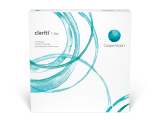Recognizing widespread digital device use in today’s “always on” society, CooperVision has released a new report to help eye care professionals better understand patients’ experiences with digital eye strain.1-3
Based on recently conducted research with 750 U.S. adults ages 18-44 requiring vision correction, the publication highlights substantial opportunity for practitioners to proactively address several device-related habits and symptoms as part of routine eye care.1
“A New Look at Digital Eye Strain” is now available for online reading or download.
“Our data shows that screen time only continues to rise.4 As a result, most people are experiencing symptoms of digital eye strain—yet they are still not having this conversation with their eye care professional,”5 said Michele Andrews, OD, Vice President, Professional and Government Affairs, CooperVision. “Consumers are interested in solutions to combat symptoms associated with digital eye strain, including contact lenses specifically designed for this purpose.”6
When asked to quantify their time in front of screens, over half of respondents said they spend six or more hours a day on average using digital devices.7 Smartphones were shown to be the most used, and for many, this behavior continues to rise, with 62% of participants noting their smartphone usage has greatly increased in the past two years.8
Prolific Digital Device Use May Lead to Digital Eye Strain—and Patients Want Solutions
With rising digital device use, digital eye strain has become all too common.1,2 Nearly seven in 10 respondents report that they experience symptoms associated with digital eye strain.9 Symptoms can include tired eyes, dryness, eye irritation or soreness, headaches, blurry vision, or tearing/watery eyes.10
While patients in the past may have been unaware that such symptoms were related to their digital device use, this no longer seems to be the case. Nearly half of respondents believed their eye tiredness was caused by screen time,11 indicating more substantial awareness of the connection between digital device use and ocular discomfort.
Patients are looking for solutions. Of the respondents who reported experiencing digital eye strain, 99% had tried at least one method for reducing associated symptoms.12
The Role of Eye Care Professionals and the Opportunity for Practices
“Practitioners can assume that virtually every patient in their chair is a digital device user,” said Dr. Andrews. “Most patients look to their eye care professionals for education and guidance on not only the symptoms they are experiencing, but the latest innovations to help.”
CooperVision’s MyDay Energys® daily disposable and Biofinity Energys® monthly replacement contact lenses combine an innovative aspheric lens design and advanced material technology to address eye tiredness and dryness associated with digital eye strain. The lenses feature DigitalBoost™ technology, a single vision aspheric lens design unique to MyDay Energys® and Biofinity Energys® that delivers a +0.3D boost, which may help ease strain so the wearer can shift focus from on screen to off with less effort.*13 In addition, Aquaform® Technology retains water from core to surface without the need for surface coating or added wetting agents in the lens material.14 This can help eyes feel less dry, even during times of reduced blinking.
“When it comes to digital eye strain, our new report points to significant potential for improving doctor-patient communication about the condition, as well as options for addressing associated symptoms,”1 said Dr. Andrews. “With MyDay Energys® and Biofinity Energys®, eye care professionals have an opportunity to make a difference in the lives of many of their patients, while also growing their businesses.”
This new data comes as CooperVision marks a milestone for its breakthrough MyDay Energys® contact lenses, acknowledging the anniversary of its first year of availability in the U.S. with a celebration on March 1 at SECO 2024 in Atlanta. Many eye care professionals have been quick to adopt the lenses to help support their spherical patients’ modern digital lifestyle, with additional growth anticipated in its second year on the market.
For more information, visit our Digital Eye Strain page.
*Based on a statistically significant difference of the mean change in Accommodative Microfluctuations and when compared to a lens without DigitalBoost™ /Digital Zone Optics® after reading on an iPhone 5 for 20 minutes held at a distance of 25 cm. Study conducted with Biofinity Energys® and sphere.
References:
1. CooperVision (February 2024). “A New Look at Digital Eye Strain”. Report of online survey results (2023): N=750, Vision corrected patients. US Adults Ages 18-44 who wear corrective spectacles and/or contact lenses.
2. Coles-Brennan C, Sulley A, Young G. Management of digital eye strain. Clinical and Experimental Optometry. 2019;102(1):18-29.
3. Vision Council 2016 Digital Eye Strain Report: Eyes overexposed, the digital device dilemma.
4. CVI data on file 2023. US online survey: N=750, Vision corrected patients. US Adults Ages 18-44 who wear corrective spectacles and/or contact lenses. 62% increased smart phone screen time, 41% increased TV screen time, 39% increased laptop screen time for both work and personal use.
5. CVI data on file 2023. US online survey: N=750, Vision corrected patients. US Adults Ages 18-44 who wear corrective spectacles and/or contact lenses. 69% experience symptoms of digital eye strain at least once a week or less. 21% have brought up to their doctor their digital device use and how it affects their eyes.
6. CVI data on file 2023. US online survey: N=750, Vision corrected patients. US Adults Ages 18-44 who wear corrective spectacles and/or contact lenses. Regardless of recommendations from their eye doctor, 56% interested/very interested.
7. CVI data on file 2023. US online survey: N=750, Vision corrected patients. US Adults Ages 18-44 who wear corrective spectacles and/or contact lenses. 52% say the spend 6 hours or more.
8. CVI data on file 2023. US online survey: n=738, Vision corrected patients. US Adults Ages 18-44 who wear corrective spectacles and/or contact lenses and use a smartphone. 62% greatly increased/increased for both work and personal use.
9. CVI data on file 2023. US online survey: N=750, Vision corrected patients. US Adults Ages 18-44 who wear corrective spectacles and/or contact lenses. 31% experience at least once a week or less, 32% experience a few days a week and 6% experience every day.
10. “Computer Vision Syndrome.” American Optometric Association.
11. CVI data on file 2023. US online survey: n=586, Vision corrected patients US Adults Ages 18-44 who wear corrective spectacles and/or contact lenses and experience eye tiredness. 48% responded that excessive screen time is what causes their eye tiredness.
12. CVI data on file 2023. US online survey: N=516, Vision corrected patients US Adults Ages 18-44 who have digital eye strain at least once a week or less and who wear corrective spectacles and/or contact lenses.
13. Kajita M et al. Changes in accommodative micro-fluctuations after wearing contact lenses of different optical designs. Cont Lens Ant Eye (2020) In Press https://doi.org/10.1016/j.clae.2020.03.003.
14. CVI data on file 2022








